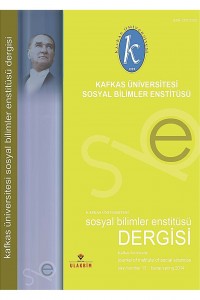Öz
Bu araştırmada çevirinin özel bir türü olan alt yazının özellikleri ve her bir boyutu bilimsel literatürün ışığında değişik filmlerden aldığımız somut alt yazı örnekleriyle tartışıldı. Bu arada alt yazı kavramı, yabancı dildeki diyalogların (repliklerin) sınırlı bir sürede izleyici tarafından okunarak görüntüyle eş süremde ilişkilendirilmesi olarak tanımlandı. Bu çeviri yönteminde izleyicilerin bir taraftan görüntüyü izlemek, diğer taraftan da alt yazıyı okumak zorunda olduğu vurgulandı. Araştırmanın akışı içinde alt yazının oluşumuyla ilgili ileri sürdüğümüz hipotezleri verdiğimiz değişik örneklerle kanıtlanmaya çalışıldı. Sonuç olarak çevirmenlerin filmdeki replikleri hedef dile biçim ve içerik açıdan en doğru bir şekilde aktarmak ve bunu yaparken ekrandaki yer sorununu ve görüntüyle birlikte zaman uyumunu da dikkate almak zorunda olduğu belirtildi
Anahtar Kelimeler
Kaynakça
- BAKER, M. (Ed.) 1998: Routledge Encyclopedia of Translation Studies. (First edit). London & New York: Routledge.
- BRONDEEL, H. 1994: “Teaching subtitling routines.” In: Meta, Journa des traducteurs 39 (1): 26-33.
- BRÄUTIGAM, T. 2001: Lexikon der Film- und Fernsehsynchronisation. Stars und Stimmen: “Wer synchronisiert wem in welchen Film?” Lexikon- Imprint-Verlag, Berlin.
- CEDEÑO ROJAS, M. 2007: Arbeitsmittel und Arbeitsabläufe beim audiovisualen Übersetzen , edited by Rosa Agost and Frederic Chaume Varela, 77–88.
- CHIARO, D. 2009: Issues in Audiovisual Translation. In J. Munday (Ed.), The Routledge Companion to Translation Studies. (Revised edition). (pp. 141- 163). Oxon: Routledge.
- DE LINDE, Z. 1999: The Semiotics of subtitling. Manchester: St. Jerome Publishing.
- GERZYMISCH-ARBOGAST, H. 2004: “Subtitling and InformationStructuring.” In: Translation Studies in the New Millennium. An International Journal of Translation and Interpreting. Volume 2 (2004).85-103
- GOTTLIEB, H. 2001a: “Untertitel- Authentizität oder Storfaktor.” In: Schnitt Nr. 21, 1/2001, 12-15.
- GOTTLIEB, H. 2001b: “Anglicisms and TV Subtitles in an AngliŞed World” In: Gambier, Y. & Gottlieb, H. (Hrsg.) (2001): (Multi) Media Translation- Concepts, Practices and Research. John Benjamins Publishing Company. Amsterdam/ Philadelphia. 249-258.
- HURT, C. ve WIDLER, B. 1998: Untertitelung/Übertitelung. Handbuch Translation, In: Snell-Hornby, M. et. al. (eds.), Tübingen: Stauffenburg. 261-263.
- JUNGST, HEIKE E. 2010: Audiovisuelles Übersetzen. Ein Lehr- und Arbeitsbuch. Narr Verlag, Tübingen
- KARAMITROGLOU, F. 1998: A proposed set of subtitling standarts for Europe. http://accurapid.com/journal/04stndrd.htm [Accesed April 2011]
- LAMBERT, J. 1988: “Language and Social Challenges for Tomorrow: Questions, Strategies, Programs.” In: Gambier (ed.): Translating for the. Media University of Turku. Centre for Translation and Interpreting. 151- 181.
- LUYKEN, Georg-Michael 1991: Overcoming Language Barriers in Television Dubbing and Subtitling for the European Audience, University of Luton.
- SNELL-HORNBY, M. 1999: Handbuch Translation. [et al.] (Hrsg.).2. verb. Aufl. Tübingen: Stauffenburg,
Öz
In this study, the features and each dimension of subtitle, a special type of translation, were discussed within the scope of scientific literature by providing the concrete subtitle examples taken from various films. Meanwhile, the concept of subtitle was defined as relating the dialogues in the foreign language to the image by reading simultaneously. In this kind of translation, it was emphasized that audiences not only have to watch the images but also read the subtitles. The hypotheses regarding the formation of subtitles were tried to be proven by the various examples provided within the course of the study. In conclusion, it was stated that translators need to translate the lines to the target language correctly both in form and content by keeping in mind the problem of space on the screen and timing with the image
Anahtar Kelimeler
Kaynakça
- BAKER, M. (Ed.) 1998: Routledge Encyclopedia of Translation Studies. (First edit). London & New York: Routledge.
- BRONDEEL, H. 1994: “Teaching subtitling routines.” In: Meta, Journa des traducteurs 39 (1): 26-33.
- BRÄUTIGAM, T. 2001: Lexikon der Film- und Fernsehsynchronisation. Stars und Stimmen: “Wer synchronisiert wem in welchen Film?” Lexikon- Imprint-Verlag, Berlin.
- CEDEÑO ROJAS, M. 2007: Arbeitsmittel und Arbeitsabläufe beim audiovisualen Übersetzen , edited by Rosa Agost and Frederic Chaume Varela, 77–88.
- CHIARO, D. 2009: Issues in Audiovisual Translation. In J. Munday (Ed.), The Routledge Companion to Translation Studies. (Revised edition). (pp. 141- 163). Oxon: Routledge.
- DE LINDE, Z. 1999: The Semiotics of subtitling. Manchester: St. Jerome Publishing.
- GERZYMISCH-ARBOGAST, H. 2004: “Subtitling and InformationStructuring.” In: Translation Studies in the New Millennium. An International Journal of Translation and Interpreting. Volume 2 (2004).85-103
- GOTTLIEB, H. 2001a: “Untertitel- Authentizität oder Storfaktor.” In: Schnitt Nr. 21, 1/2001, 12-15.
- GOTTLIEB, H. 2001b: “Anglicisms and TV Subtitles in an AngliŞed World” In: Gambier, Y. & Gottlieb, H. (Hrsg.) (2001): (Multi) Media Translation- Concepts, Practices and Research. John Benjamins Publishing Company. Amsterdam/ Philadelphia. 249-258.
- HURT, C. ve WIDLER, B. 1998: Untertitelung/Übertitelung. Handbuch Translation, In: Snell-Hornby, M. et. al. (eds.), Tübingen: Stauffenburg. 261-263.
- JUNGST, HEIKE E. 2010: Audiovisuelles Übersetzen. Ein Lehr- und Arbeitsbuch. Narr Verlag, Tübingen
- KARAMITROGLOU, F. 1998: A proposed set of subtitling standarts for Europe. http://accurapid.com/journal/04stndrd.htm [Accesed April 2011]
- LAMBERT, J. 1988: “Language and Social Challenges for Tomorrow: Questions, Strategies, Programs.” In: Gambier (ed.): Translating for the. Media University of Turku. Centre for Translation and Interpreting. 151- 181.
- LUYKEN, Georg-Michael 1991: Overcoming Language Barriers in Television Dubbing and Subtitling for the European Audience, University of Luton.
- SNELL-HORNBY, M. 1999: Handbuch Translation. [et al.] (Hrsg.).2. verb. Aufl. Tübingen: Stauffenburg,
Ayrıntılar
| Birincil Dil | Türkçe |
|---|---|
| Bölüm | Makaleler |
| Yazarlar | |
| Yayımlanma Tarihi | 1 Haziran 2014 |
| Yayımlandığı Sayı | Yıl 2014 Cilt: 1 Sayı: 13 |


